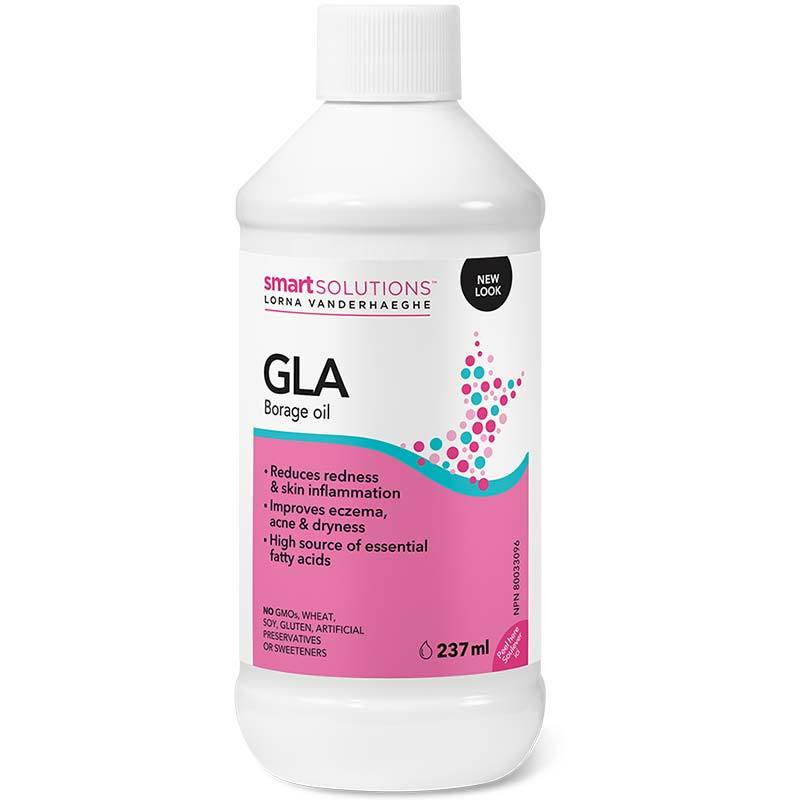Lorna Vanderhaeghe
Lorna Vanderhaeghe GLA Borage Oil 237ml
Lorna Vanderhaeghe GLA Borage Oil 237ml
Impossible de charger la disponibilité du service de retrait
- Ensures beautiful, smooth, glowing skin
- Improves calcium retention in bones
- Treats eczema, psoriasis and dermatitis
- Stops breast and period pain
- Stops cradle cap and dermatitis in infants
- Can also be applied topically along with oral treatment
- NPN 80033096
PRODUCT INFORMATION
GLA is a Very Essential Fat
Fatty acids are good fats for optimal health. Unfortunately the North American diet is made up predominantly of bad fats from red meats and processed foods. To make matters worse when an enzyme in the body is impaired we can't make the good fats GLA, EPA or DHA. We can overcome this problem by eating fish or fish oils that contain EPA and DHA but when it comes to GLA the only way to get this important fatty acid is to take it in a nutritional supplement.
GLA (gamma linolenic acid) is found in borage oil (20 to 24%) and to a lesser extent evening primrose oil (8 to 10%). GLA is not found in food in high enough quantities to maintain our needs through diet alone.
GLA Eases Cramps and Breast Pain
GLA deficiency is a major cause of PMS. A healthy body creates GLA via an enzyme from fats such as sunflower oil into prostaglandins, which are hormone-like compounds that regulate blood clotting, inflammation and muscle contraction. Just before menstruation a cascade of prostaglandins are initiated in the uterus which causes the constriction of blood vessels and contractions that cause pain, cramps, nausea, vomiting, bloating and headaches that coincide with PMS. There are good prostaglandins and bad prostaglandins. Painful menstruation and breast pain are caused by low levels of good anti-inflammatory prostaglandins which are made from GLA. In many women with breast pain and terrible PMS their ability to make GLA is often impaired. One trial done at the breast clinic at the University of Hong Kong used GLA for the treatment of cyclical breast pain. Of the 66 women in the study 97% responded to treatment with GLA after 6 months. Further studies have found unusually low concentrations of GLA in the women suffering with period cramps and breast pain. The recommended dose is 1000-2000 mg of GLA per day.
GLA, Menopause and Skin
In women who have gone through menopause, the enzyme that converts food into GLA becomes impaired. GLA is a major component of beautiful skin. GLA makes your skin luminescent, dewy and glowing. The main reason our skin becomes dull and thick after menopause is due to the inability to make GLA. After menopause it is essential that we take a daily dose of GLA to ensure beautiful skin. As we age GLA can reduce inflammation in the skin associated with wrinkled skin. Without sufficient GLA the skin becomes dry, rough and wrinkled.
GLA and Skin Health
GLA helps to maintain the stability and fluidity of the natural water loss barrier in our skin. Skin disorders like eczema, psoriasis, rosacea, dermatitis, cradle cap, acne and dry skin occur. GLA is vital for keeping skin cells moist and strong improving the barrier function of the skin. In one study, 60 patients given 500 mg of GLA per day for eczema had a 90% improvement over 12 weeks. Eczema is a common problem in infants and children. GLA is safe for all ages without the side effects seen with steroid creams.
Cradle cap and infant dermatitis or dry crusts on the skin occur on the scalp, face, armpits, chest and groin area and can be treated with topical GLA oil. 48 infants with dermatitis were given twice daily applications of GLA oil for 6 weeks with complete relief. One teaspoon containing 500 mg of GLA should be applied twice a day.
GLA has also been found to inhibit male hormones in the skin that cause acne. GLA can be taken both internally and applied externally to acne prone areas with excellent results.
GLA and Bone Density
Studies performed over 18 months found that when GLA was combined with calcium, GLA enhanced the absorption of calcium and improved bone density and prevented bone loss. Sixty five women with an average age of 79 years were given 600 mg of calcium glycinate/aspartate along with 1000 mg of GLA and had up to a 2% increase in bone density whereas the group receiving calcium alone lost 2 to 3% of bone over the 18 month period.
Borage oil is the highest source of GLA. GLA SKIN OIL contains 500 mg of GLA per serving.SUGGESTED USE
Take 1 to 2 teaspoons daily with food and/or apply to the skin as needed.
Share


